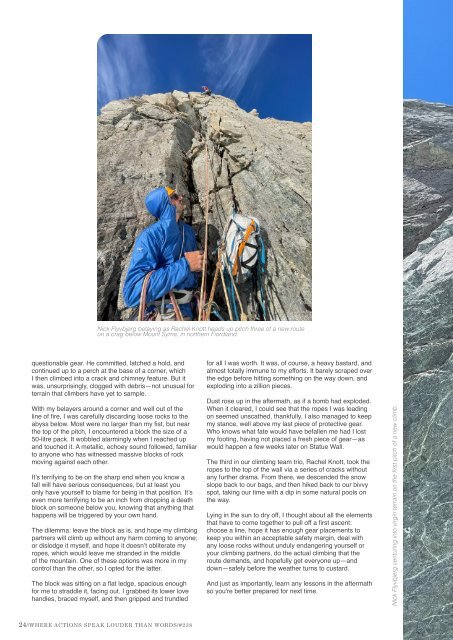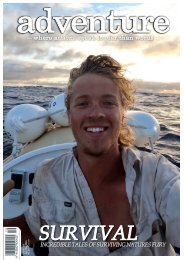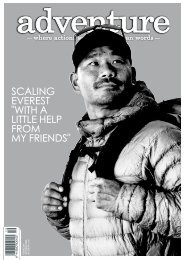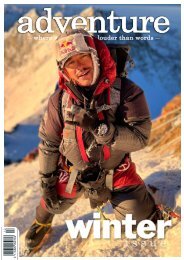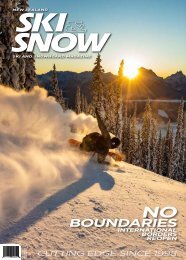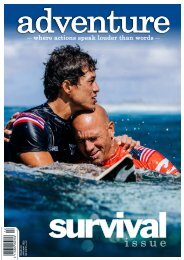Create successful ePaper yourself
Turn your PDF publications into a flip-book with our unique Google optimized e-Paper software.
Nick Flyvbjerg belaying as Rachel Knott heads up pitch three of a new route<br />
on a crag below Mount Syme, in northern Fiordland.<br />
questionable gear. He committed, latched a hold, and<br />
continued up to a perch at the base of a corner, which<br />
I then climbed into a crack and chimney feature. But it<br />
was, unsurprisingly, clogged with debris—not unusual for<br />
terrain that climbers have yet to sample.<br />
With my belayers around a corner and well out of the<br />
line of fire, I was carefully discarding loose rocks to the<br />
abyss below. Most were no larger than my fist, but near<br />
the top of the pitch, I encountered a block the size of a<br />
50-litre pack. It wobbled alarmingly when I reached up<br />
and touched it. A metallic, echoey sound followed, familiar<br />
to anyone who has witnessed massive blocks of rock<br />
moving against each other.<br />
It’s terrifying to be on the sharp end when you know a<br />
fall will have serious consequences, but at least you<br />
only have yourself to blame for being in that position. It’s<br />
even more terrifying to be an inch from dropping a death<br />
block on someone below you, knowing that anything that<br />
happens will be triggered by your own hand.<br />
The dilemma: leave the block as is, and hope my climbing<br />
partners will climb up without any harm coming to anyone;<br />
or dislodge it myself, and hope it doesn’t obliterate my<br />
ropes, which would leave me stranded in the middle<br />
of the mountain. One of these options was more in my<br />
control than the other, so I opted for the latter.<br />
The block was sitting on a flat ledge, spacious enough<br />
for me to straddle it, facing out. I grabbed its lower love<br />
handles, braced myself, and then gripped and trundled<br />
for all I was worth. It was, of course, a heavy bastard, and<br />
almost totally immune to my efforts. It barely scraped over<br />
the edge before hitting something on the way down, and<br />
exploding into a zillion pieces.<br />
Dust rose up in the aftermath, as if a bomb had exploded.<br />
When it cleared, I could see that the ropes I was leading<br />
on seemed unscathed, thankfully. I also managed to keep<br />
my stance, well above my last piece of protective gear.<br />
Who knows what fate would have befallen me had I lost<br />
my footing, having not placed a fresh piece of gear—as<br />
would happen a few weeks later on Statue Wall.<br />
The third in our climbing team trio, Rachel Knott, took the<br />
ropes to the top of the wall via a series of cracks without<br />
any further drama. From there, we descended the snow<br />
slope back to our bags, and then hiked back to our bivvy<br />
spot, taking our time with a dip in some natural pools on<br />
the way.<br />
Lying in the sun to dry off, I thought about all the elements<br />
that have to come together to pull off a first ascent:<br />
choose a line, hope it has enough gear placements to<br />
keep you within an acceptable safety margin, deal with<br />
any loose rocks without unduly endangering yourself or<br />
your climbing partners, do the actual climbing that the<br />
route demands, and hopefully get everyone up—and<br />
down—safely before the weather turns to custard.<br />
And just as importantly, learn any lessons in the aftermath<br />
so you're better prepared for next time.<br />
Nick Flyvbjerg venturing into virgin terrain on the first pitch of a new climb.<br />
24//WHERE ACTIONS SPEAK LOUDER THAN WORDS/<strong>#238</strong>


